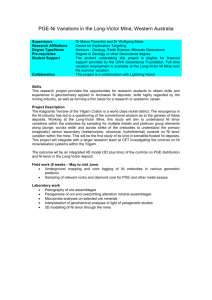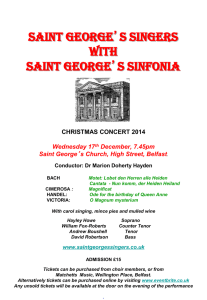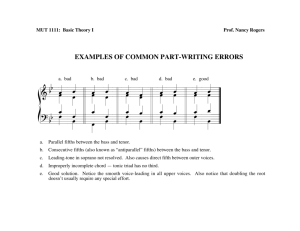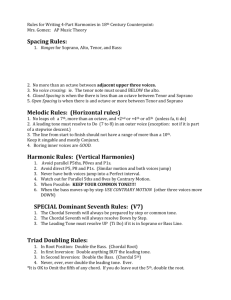Tenor Voice Range Handout
advertisement
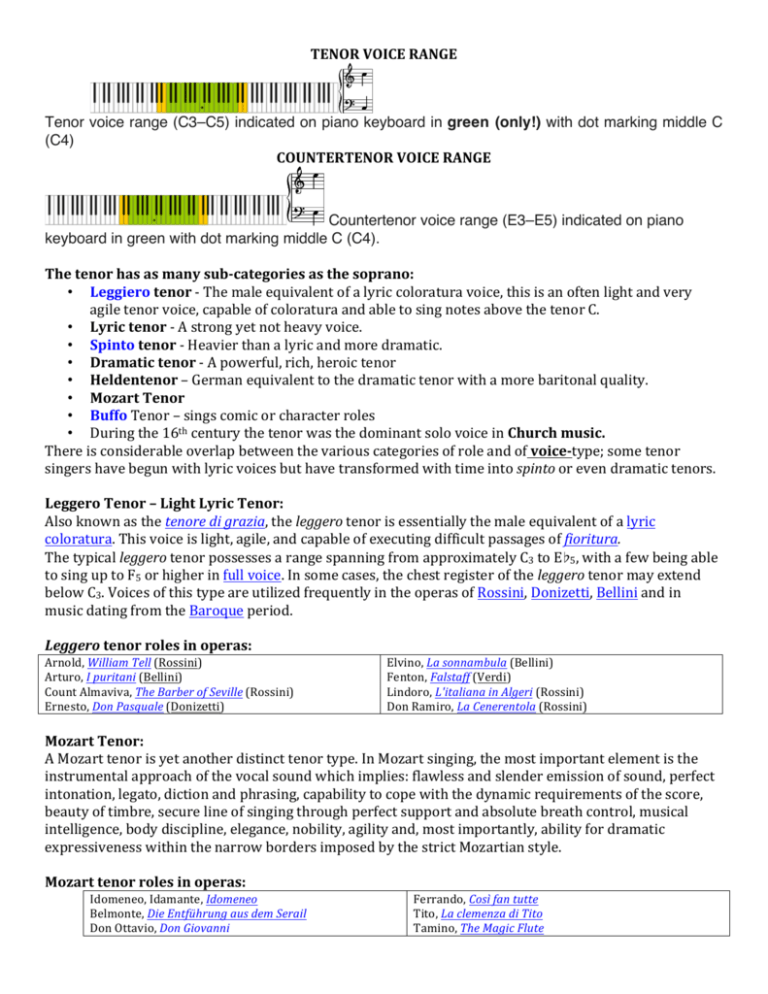
TENOR VOICE RANGE Tenor voice range (C3–C5) indicated on piano keyboard in green (only!) with dot marking middle C (C4) COUNTERTENOR VOICE RANGE Countertenor voice range (E3–E5) indicated on piano keyboard in green with dot marking middle C (C4). The tenor has as many sub-­‐categories as the soprano: • Leggiero tenor -­‐ The male equivalent of a lyric coloratura voice, this is an often light and very agile tenor voice, capable of coloratura and able to sing notes above the tenor C. • Lyric tenor -­‐ A strong yet not heavy voice. • Spinto tenor -­‐ Heavier than a lyric and more dramatic. • Dramatic tenor -­‐ A powerful, rich, heroic tenor • Heldentenor – German equivalent to the dramatic tenor with a more baritonal quality. • Mozart Tenor • Buffo Tenor – sings comic or character roles • During the 16th century the tenor was the dominant solo voice in Church music. There is considerable overlap between the various categories of role and of voice-­‐type; some tenor singers have begun with lyric voices but have transformed with time into spinto or even dramatic tenors. Leggero Tenor – Light Lyric Tenor: Also known as the tenore di grazia, the leggero tenor is essentially the male equivalent of a lyric coloratura. This voice is light, agile, and capable of executing difficult passages of fioritura. The typical leggero tenor possesses a range spanning from approximately C3 to E♭5, with a few being able to sing up to F5 or higher in full voice. In some cases, the chest register of the leggero tenor may extend below C3. Voices of this type are utilized frequently in the operas of Rossini, Donizetti, Bellini and in music dating from the Baroque period. Leggero tenor roles in operas: Arnold, William Tell (Rossini) Arturo, I puritani (Bellini) Count Almaviva, The Barber of Seville (Rossini) Ernesto, Don Pasquale (Donizetti) Elvino, La sonnambula (Bellini) Fenton, Falstaff (Verdi) Lindoro, L'italiana in Algeri (Rossini) Don Ramiro, La Cenerentola (Rossini) Mozart Tenor: A Mozart tenor is yet another distinct tenor type. In Mozart singing, the most important element is the instrumental approach of the vocal sound which implies: flawless and slender emission of sound, perfect intonation, legato, diction and phrasing, capability to cope with the dynamic requirements of the score, beauty of timbre, secure line of singing through perfect support and absolute breath control, musical intelligence, body discipline, elegance, nobility, agility and, most importantly, ability for dramatic expressiveness within the narrow borders imposed by the strict Mozartian style. Mozart tenor roles in operas: Idomeneo, Idamante, Idomeneo Belmonte, Die Entführung aus dem Serail Don Ottavio, Don Giovanni Ferrando, Così fan tutte Tito, La clemenza di Tito Tamino, The Magic Flute The Lyric Tenor: The lyric tenor is a warm graceful voice with a bright, full timbre that is strong but not heavy and can be heard over an orchestra. Lyric tenors have a range from approximately the C one octave below middle C (C3) to the D one octave above middle C (D5). Similarly, their lower range may extend a few notes below the C3. There are many vocal shades to the lyric tenor group, repertoire should be selected according to the weight, colors, and abilities of the voice. Lyric tenor roles in operas: Alfredo, La traviata (Verdi) David, Die Meistersinger von Nürnberg (Wagner) The Duke of Mantova, Rigoletto (Verdi) Edgardo, Lucia di Lammermoor (Donizetti) Faust, Faust (Gounod) Hoffmann, The Tales of Hoffmann (Offenbach) Lensky, Eugene Onegin (Tchaikovsky) Rodolfo, La bohème (Puccini) Roméo, Roméo et Juliette (Gounod) Werther, Werther (Massenet) The Spinto Tenor: Spinto from the Italian means "pushed") (Sometimes the terms lirico-­‐spinto or jugendlich-­‐dramatisch are used to denote this category of voice. The spinto tenor has the brightness and height of a lyric tenor, but with a heavier vocal weight enabling the voice to be "pushed" to dramatic climaxes with less strain than the lighter-­‐voice counterparts. Spinto tenors have a darker timbre than a lyric tenor, without having a vocal color as dark as many (not all) dramatic tenors. The German equivalent of the spinto fach is the Jugendlicher Heldentenor and encompasses many of the Dramatic tenor roles as well as some Wagner roles such as Lohengrin and Stolzing. The difference is often the depth and metal in the voice where some lyric tenors age or push their way into singing as a spinto giving them a lighter tone and a Jugendlicher (Youthful) Heldentenor tends to be either a young heldentenor or true lyric spinto. Spinto tenors have a range from approximately the C one octave below middle C (C3) to the C one octave above middle C (C5). Examples of spinto roles: Andrea Chénier, Andrea Chénier (Giordano) Calaf, Turandot (Puccini) Canio, I Pagliacci (Leoncavallo) Des Grieux, Manon Lescaut (Puccini) Don Carlo, Don Carlos (Verdi) Don José, Carmen (Bizet) Erik, Der Fliegende Holländer (Wagner) Manrico, Il trovatore (Verdi) Mario Cavaradossi, Tosca (Puccini) Radames Aida (Verdi) Gustavo, Un ballo in maschera (Verdi) Turiddù, Cavalleria rusticana (Mascagni) Dramatic Tenor: Also "tenore di forza" or "robusto", the dramatic tenor has an emotive, ringing and very powerful, clarion, heroic tenor sound. The dramatic tenor's approximate range is from the B one octave below middle C (B2) to the B one octave above middle C (B4) with some able to sing up to the C one octave above middle C (C5). Many successful dramatic tenors though have historically avoided the coveted high C in performance. Their lower range tends to extend into the baritone tessitura or, a few notes below the C3, even down to A♭2. Some dramatic tenors have a rich and dark tonal color to their voice (such as the mature Enrico Caruso) while others possess a bright, steely timbre. Dramatic tenor roles in operas: Canio, Pagliacci (Leoncavallo) Dick Johnson, La fanciulla del West (Puccini) Don Alvaro, La forza del destino (Verdi) Enée, Les Troyens (Berlioz) Florestan, Fidelio (Beethoven) Otello, Otello (Verdi) Erik, Der Fliegende Holländer (Wagner) Manrico, Il trovatore (Verdi) Mario Cavaradossi, Tosca (Puccini) Radamès Aida (Verdi) Gustavo, Un ballo in maschera (Verdi) Turiddù, Cavalleria rusticana (Mascagni) Heldentenor: The heldentenor (English: heroic tenor) has a rich, dark, powerful and dramatic voice. As its name implies, the heldentenor vocal fach features in the German romantic operatic repertoire. The heldentenor is the German equivalent of the tenore drammatico, however with a more baritonal quality: the typical Wagnerian protagonist. Often the heldentenor is a baritone who has transitioned to this fach or tenors who have been misidentified as baritones. Therefore the heldentenor voice might or might not have facility up to high B or C. The repertoire, however, rarely calls for such high notes. Heldentenor roles in operas: Florestan, Fidelio (Beethoven) Tannhäuser, Tannhäuser (Wagner) Lohengrin, Lohengrin (Wagner) Siegmund, Die Walküre (Wagner) Siegfried, Siegfried (Wagner) Tristan, Tristan und Isolde (Wagner) Parsifal, Parsifal (Wagner) Bacchus, Ariadne auf Naxos (Strauss) The Emperor, Die Frau ohne Schatten (Strauss) Paul, Die tote Stadt (Korngold) Buffo Tenor: A Tenor buffo is a tenor with good acting ability, and the ability to create distinct voices for his characters. This voice specializes in smaller comic roles. The range of the tenor buffo is from the C one octave below middle C (C3) to the B above middle C (B4). The tessitura of these parts lies lower than the other tenor roles. These parts are often played by younger tenors who have not yet reached their full vocal potential or older tenors who are beyond their prime singing years. Only rarely will a singer specialize in these roles for an entire career. The Buffo tenor roles in operas: Count Danilo, The Merry Widow (Lehár) Don Basilio, The Marriage of Figaro (Mozart) Mime, Der Ring des Nibelungen (Wagner) Monostatos, The Magic Flute (Mozart) Pedrillo, Die Entführung aus dem Serail (Mozart) Kálmán Zsupán, The Gypsy Baron (Strauss II) The Magician, The Consul (Menotti) Beppe, I Pagliacci (Leoncavallo) Frantz, The Tales of Hoffmann (Offenbach) Spoletta, Tosca (Puccini) Goro, Madama Butterfly (Puccini) Pong, Turandot (Puccini)



